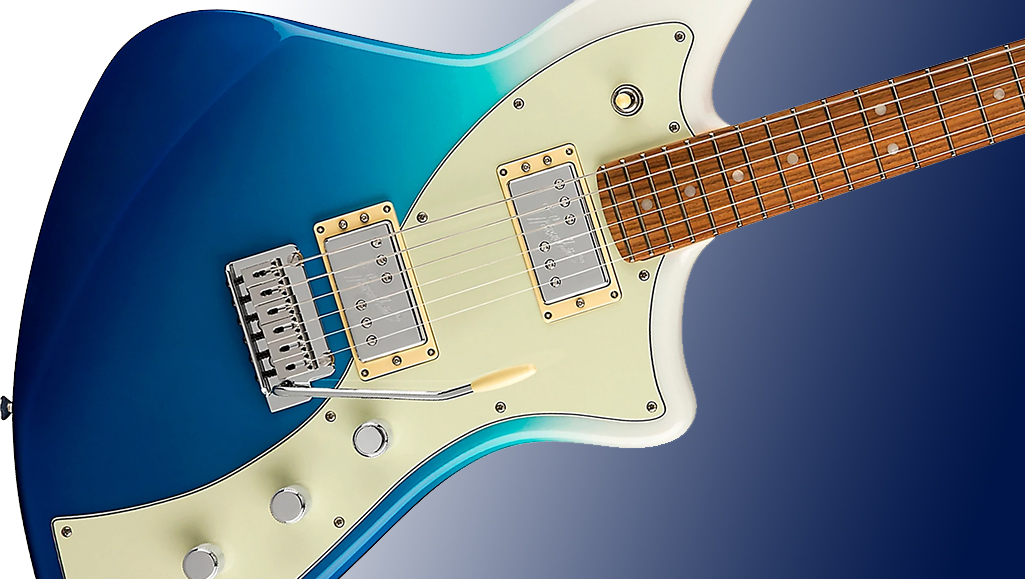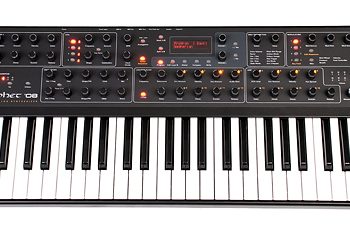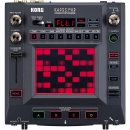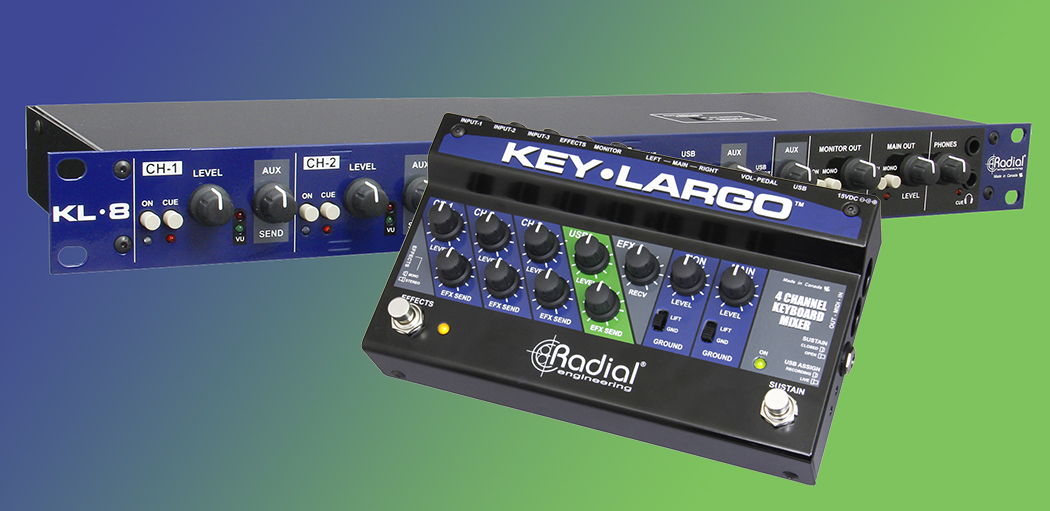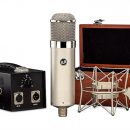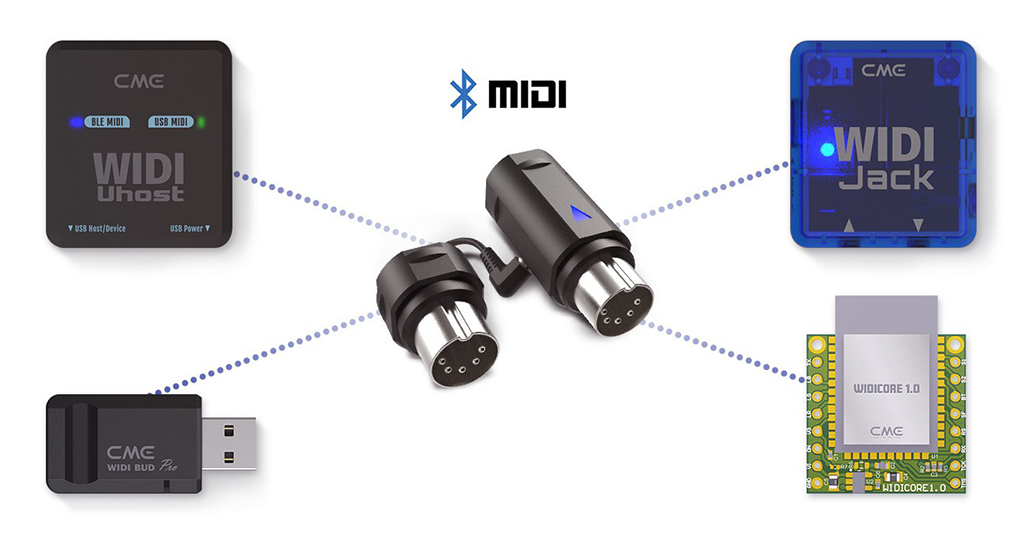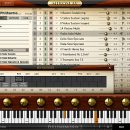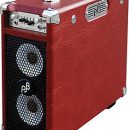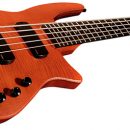First, we played (and reviewed) guitars made from carbon fiber, but that material sounded too cold and sterile to really excite us. Next, we played guitars made from Flaxwood, a proprietary material essentially made from recycled wood chips bonded to a plastic resin, and this created beautiful wood tone that worked great for clean and light rock sounds, but something about it just didn’t sit right with us for high-gain metal music (at least in the guitar reviewed).
Enter the Aristides 010, a sleek guitar seemingly lifted out of a science fiction movie (but merely transported from Amsterdam), made from yet another proprietary material — Arium. This guitar was born to rock, which it does in spades. We can say without question that the Aristides 010 is our favorite sounding guitar made from non-wood material, which is to say that it sounds just as good as any other premium, solid-body, wood guitar. But although the flashy looks and Adrian Vandenberg endorsement may scream metal to you, this is no one trick pony. The 010 is a fantastic sounding alternative to a traditional Strat, boasting all the spank without the plank.
The advantages of material like Arium are significant: it is nearly impervious to the effects of moisture change, like hopping out of an air conditioned dressing room and onto the stage at an outdoors music festival in the heat and humidity of a summertime show in the Southeast. And it’s also great for the environment, as we all know that premium tonewoods are becoming a scarce resource.
If you’re looking for traditional Strat-like tones coupled with high gain humbucker tone suited to modern metal, with superb playability and tuning stability, but are tired of the usual options, the Aristides 010 is definitely a guitar that belongs on your short list.
Features
The first thing we noticed was the unique gig bag containing the 010, a pod-shaped canvas enclosure surrounding a foam cradle in which we found Batman’s evil spawn — the matte black Aristides 010 electric guitar. With a design sure to inspire some and offend others (we saw both reactions even within our office), the guitar is certainly modern in its appearance and sure to help you strike up conversations with anyone who sees you play the instrument.
Arium was developed with the goal of developing a material that exhibited perfect acoustic properties. The resulting material is a composition of specific resins and microscopic glass particles. While wood vibrates in specific directions in relation to the grain structure of the selected wood type, Arium was developed so that it would resonate unhindered by the presence of a grain structure imposing a limitation on the vibration.
This material starts out in liquid form, and the guitar is fabricated in a mold, built up in layers, creating (ultimately) a unique, one-piece construction. It’s not neck-thru — it’s one whole slab of instrument! At 8.4 lbs, it has a comfortable weight that won’t vary from one unit to the next, as you’d find with different slabs of wood.
The c-shaped neck features a compound radius, ebony fretboard: 10” at the nut and 16” at the 22nd fret. It is capped with premium materials including a Graph Tech nut, Sperzel locking tuners, and 22 medium jumbo frets.
 The bridge is a Gotoh Wilkinson VS100N tremolo, a model that we’ve been quite happy with on a variety of other premium instruments. Our only surprise was that given the premium nature of this instrument, there is no option for the inclusion of piezo acoustic saddles that are routinely available with Wilkinson tremolos.
The bridge is a Gotoh Wilkinson VS100N tremolo, a model that we’ve been quite happy with on a variety of other premium instruments. Our only surprise was that given the premium nature of this instrument, there is no option for the inclusion of piezo acoustic saddles that are routinely available with Wilkinson tremolos.
In keeping with the unique properties of the Aristides 010, we were excited to discover that their pickup selection wasn’t the same old, classic Seymour Duncan JB/Jazz/’59 selection but rather a Duncan TB-5 bridge humbucker, APS-2rwrp single-coil (middle), and APS-2 single-coil (neck).
A master volume, tone control, and five-way blade selector rounded out the controls, and Schaller strap locks (our favorite) are installed by default. Buried in the guts of the guitar is a Snagg microchip with a unique, scannable code, so after the guy at the pawn shop gets past his “what the heck is that guitar?” reaction, he can identify the instrument’s rightful owner.
Usability
After shipping from Holland to our US headquarters, but first getting held up in customs somewhere down in the Carolinas, we were pleasantly surprised to find the guitar virtually in tune upon removing it from the case, no small feat for a guitar with a non-locking, fully floated tremolo.
Aside from its unique composition, the Aristides 010 is essentially a double cut-away Strat-style guitar with a sleek feel to match the sleek looks. The guitar is well balanced, and it conformed nicely to our bodies whether standing or seated. At 8.4 lbs, it’s light enough not to induce backaches.
The neck heel joins the body seamlessly, allowing unhindered access to the uppermost frets. The 22 jumbo frets were polished and seated seamlessly, with no sharp edges, buzzes or “fret out.” The neck’s oval, “c” shape felt just right in our hands — not too thin and not too beefy. Our evaluation model was set up with a relatively low and comfortable action, yet still had enough clearance to allow us to get under the strings for some big bends. In all honesty, our guitar probably had a little too much relief in the neck, which would have been easy to correct by simply adjusting the truss rod that was conveniently located above the nut.
The controls are pretty much standard fare for anyone used to playing a Stratocaster. A five-way blade switch controls the pickup selection and all three pickups share a single volume and tone pot. The volume pot is located fairly low on the body, which is not a problem if you are using it as a glorified On/Off switch, but this is problematic if you like to do volume swells with your pinky. Furthermore, the pot is not exactly low friction – it is very stiff.
Intonation was spot on, and chords played perfectly in tune at all positions on the neck. This can be attributed not only to a good setup from the factory, but the unique alignment of the GraphTech nut, which further helps to ensure fantastic intonation.
The Wilkinson VS100N (Gotoh-manufactured) bridge/tremolo and Sperzel locking tuners also performed flawlessly through countless dive-bombs and Steve Vai-esque pitch-bending escapades. The cool thing about this tremolo system is not only great tuning stability, but the ability to stay in tune even if you break a string. Furthermore, it is much easier to change strings than with a Floyd Rose-style system; in fact it’s not much harder than changing strings on your basic Strat.
The guitar ships in a tailor made “light” case, and although it’s described as a custom molded, heavy-duty case, it’s actually a canvas wrap around high density foam. This cradles the guitar beautifully for shipping — and it weighs next to nothing, but we wouldn’t want to drop an amp on this case with the guitar inside.
Sound
If the proprietary material Arium sounds like something from another planet, one thing is for sure – that planet must have some great guitar tone!
Any regular reader of our reviews knows that the first thing we typically do when testing the sonic qualities of a guitar is play it unplugged. The 010 sports an almost piano-like quality, especially on the treble strings, which rang out loudly, yet retained warmth. In fact, LOUD is the operative word here — the 010 just may be the loudest unplugged guitar we have ever played!
We lined up a few test amplifiers including a 1972 Marshall Super Lead, a Rivera Hundred Duo Twelve, and a 2010 Mesa/Boogie Dual Rectifier. The 010 running straight into our Marshall yielded an instant classic rock/metal vibe. We are big fans of the ceramic magnet, Duncan Custom (TB-5) humbucker and during this evaluation, we were reminded why. Unlike other hot ceramic pickups, the TB-5 is by no means cold or sterile, nor does it have any odd or annoying spikes, particularly in the midrange. All of the great acoustic properties we heard earlier translated beautifully through our cranked amp, and the guitar sounded punchy and percussive – almost like a snare drum! Single, sustained notes were a joy to behold, particularly the note “bloom,” which exhibited the tonal effect of opening up and evolving as the note sustained. And sustain it did… almost to infinity!
Plugged into our Mesa/Boogie Dual Rectifier, we dialed in some serious modern high gain tone. Again, the TB-5 performed admirably, never losing definition, and it was more than up to the task of handling the myriad modern metal riffs we threw at it! Complex chords rang out nicely and sustained with loads of chewy harmonics. But in case you are starting to think the TB-5 is a one trick pony – guess again. Plugged into our Rectifier’s fantastic clean channel (read the full review here), the TB-5 gave up an almost country-like Telecaster twang perfect for chicken-picked licks and rockabilly.
The middle and neck position pickups are Duncan APS-2 single coils, the middle position featuring a reverse-wound model to provide hum cancelling in certain positions only. These single coils handled things quite well tonewise in our high gain settings (the neck position in particular is great for that Ritchie Blackmore/Yngwie Malmsteen singing lead tone). However, with hum cancelling only employed in positions 2 and 4, under a fair amount of gain the 60-cycle hum is pretty bad, rendering certain pickup settings almost useless in the high-gain amp pairing unless you employ some external noise gate tools in your rig.
Through the clean channel of our Rivera Hundred Duo twelve, the APS-2 single coils sang a radically different tune. These are literally some of the best clean Strat tones we have ever heard – bar none. You may think our earlier comment about “all the spank without the plank” was just us trying to be cute, but this guitar gives up the “spank” in spades! Positions 2 and 4 on the blade gave us that instantly recognizable “quack” sound, while the middle and neck positions provided an authentic tone perfect for Hendrix, SRV, David Gilmour, or Mark Knopfler. In this context, you can really hear the sonic qualities of the 010 shine through: the piano-like ring, the bell-like chime, the deep cello like bass… it’s all there. Placing a tube screamer in front of the amp opened up the tonal possibilities even further, taking us deep into Eric Clapton territory.
If we had to critique one thing though, it would be the tremolo springs, which were quite noisy, especially when the guitar was played at loud volumes. Noisy springs are a common problem and are by no means the result of any design flaw in the instrument itself, but it was so distracting at times we wished this wonderful sounding guitar shipped with a set of noiseless springs or was dampened internally to eradicate the noise.

Documentation and Product Support
The 010 included a quick reference sheet explaining how to adjust string height and intonation on the Wilkinson tremolo, but there were no other instructions regarding maintenance, nor background information on this special instrument.
The website has video demos and specs, but no additional support materials.
Price
The Aristides 010 Black (€ 3.350) will set Americans back roughly $5,400 as of August 2011, which makes the 010 pricier than our favorite, overpriced boutique instruments from the other guys better known stateside. But, it does include a nice, leather strap with the Aristides name on it, and that funky, egg-shaped carrying case. Spend a little bit more and you can get the guitar wrapped in an aluminum finish (but with the same tone), though we prefer the black.
If you only require a single guitar for your desert island stay, the good news is that this one won’t get warped by the sun and humidity, but still, this price will ensure that only European and Japanese rockers have the pleasure of owning these superb guitars on any regular basis.
Contact Information
Aristides Instruments
www.aristidesinstruments.com



